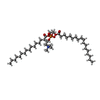+Search query
-Structure paper
| Title | Cannabidiol sensitizes TRPV2 channels to activation by 2-APB. |
|---|---|
| Journal, issue, pages | Elife, Vol. 12, Year 2023 |
| Publish date | May 18, 2023 |
 Authors Authors | Aaron Gochman / Xiao-Feng Tan / Chanhyung Bae / Helen Chen / Kenton J Swartz / Andres Jara-Oseguera /  |
| PubMed Abstract | The cation-permeable TRPV2 channel is important for cardiac and immune cell function. Cannabidiol (CBD), a non-psychoactive cannabinoid of clinical relevance, is one of the few molecules known to ...The cation-permeable TRPV2 channel is important for cardiac and immune cell function. Cannabidiol (CBD), a non-psychoactive cannabinoid of clinical relevance, is one of the few molecules known to activate TRPV2. Using the patch-clamp technique, we discover that CBD can sensitize current responses of the rat TRPV2 channel to the synthetic agonist 2-aminoethoxydiphenyl borate (2-APB) by over two orders of magnitude, without sensitizing channels to activation by moderate (40°C) heat. Using cryo-EM, we uncover a new small-molecule binding site in the pore domain of rTRPV2 in addition to a nearby CBD site that had already been reported. The TRPV1 and TRPV3 channels are also activated by 2-APB and CBD and share multiple conserved features with TRPV2, but we find that strong sensitization by CBD is only observed in TRPV3, while sensitization for TRPV1 is much weaker. Mutations at non-conserved positions between rTRPV2 and rTRPV1 in either the pore domain or the CBD sites failed to confer strong sensitization by CBD in mutant rTRPV1 channels. Together, our results indicate that CBD-dependent sensitization of rTRPV2 channels engages multiple channel regions, and that the difference in sensitization strength between rTRPV2 and rTRPV1 channels does not originate from amino acid sequence differences at the CBD binding site or the pore domain. The remarkably robust effect of CBD on TRPV2 and TRPV3 channels offers a promising new tool to both understand and overcome one of the major roadblocks in the study of these channels - their resilience to activation. |
 External links External links |  Elife / Elife /  PubMed:37199723 / PubMed:37199723 /  PubMed Central PubMed Central |
| Methods | EM (single particle) |
| Resolution | 3.23 - 3.32 Å |
| Structure data | EMDB-40582, PDB-8slx: EMDB-40583, PDB-8sly: |
| Chemicals |  ChemComp-P0T:  ChemComp-NA:  ChemComp-HOH:  ChemComp-POV: |
| Source |
|
 Keywords Keywords | MEMBRANE PROTEIN / Transport protein |
 Movie
Movie Controller
Controller Structure viewers
Structure viewers About Yorodumi Papers
About Yorodumi Papers







 Homo sapiens (human)
Homo sapiens (human)
